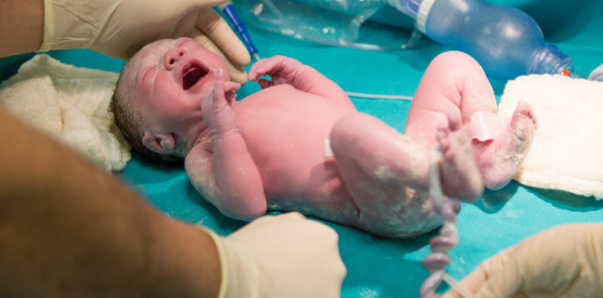Pregnancy, Birth
Nuchal cord: What to know if the umbilical cord is around baby’s neck
The thought of the umbilical cord wrapping around their baby’s neck is something many pregnant women fear. To help you understand what’s happening and to put your mind at ease, this article provides everything you need to know about nuchal cords.
Nuchal cords are very common
In Australia, up to 1 in 3 babies are born with the cord wrapped around their neck. That’s as many babies as those who are born via c-section. So, it’s far from rare and it’s usually not a big deal.
Your baby’s movements are one of the main causes
Cords can range in length from 19 to 133 centimetres at birth, so it’s no wonder they get tangled up in it sometimes. As they grow and there’s less space and fluid to move in, the cord doesn’t move or slip off their body as easily.
Babies can’t be ‘strangled’ by the umbilical cord
Within the womb, babies don’t breathe through their nose or mouth so it can’t be ‘cut off’ when the cord is around their neck. They actually don’t start breathing until after the birth when oxygen hits their nose. Instead, they receive oxygen and all the necessary nutrients via the umbilical cord.
The cord is carefully designed and well-protected
For the vast majority of babies, a normal, healthy cord is filled with a jelly-like substance called ‘Wharton’s jelly’, which protects the blood cells within. It helps to protect it against true knots (although that can happen but only in about 1% of cases) and compression. As your baby grows, so does the cord.
A nuchal cord doesn’t get tighter during labour
Dr Rachel Reed, Australian midwife, researcher and lecturer, who studied nuchal cords for her PhD, explains:
“It’s not until the baby’s head moves into the vagina, that a few extra centimetres of additional length are required. However, when a c-section is done for ‘fetal distress’ or ‘lack of progress’ during labour, the presence of a nuchal cord is often used as the reason… “ah ha, look ” your baby was stressed because the cord was around his neck” or “…the cord was stopping her from moving down”. The cord is unlikely to have had anything to do with the stress or lack of progress.”
A nuchal cord isn’t a reason for a c-section
Researchers have not found any evidence that a c-section is necessary when a nuchal cord is present.
It is unlikely to cause adverse perinatal outcomes
A nuchal cord can be present in babies with other complications, but it is unlikely to be the main cause.
Cord accidents can happen, but they are rare
In Australia, 1 out of every 135 babies is stillborn. Of those, 10% are assumed to be due to cord problems, but nuchal cord isn’t the only cord problem. It’s been found that the chance of a nuchal cord accident, such as cutting off oxygen to the brain, is very small, and possibly not the cause of death at all.
The number of loops of cord around a baby is unimportant
The number of times the cord is wrapped around the baby varies. As long as there is enough cord to get the baby’s head out of the length of the vagina, then the baby can come out to have the cord manually unwrapped.
An induction can cause fetal distress rather than the cord
When a woman is artificially induced, she might opt for an epidural. For various reasons, both of these interventions can lead to fetal distress (rather than the nuchal cord), and then an emergency c-section may be performed.
To avoid stress and complications at birth with a nuchal cord
- Avoid an unnecessary induction. Ask for evidence that the baby needs to be born before they’re ready.
- Try to avoid giving birth on your back, which means saying no to an epidural. It can result in difficulties and further interventions.
- Having a doula with you during labour to advocate for you, can help to minimise unnecessary interventions.
- Understand that the doctors and midwives don’t always have the answers to why complications occur. Much more research needs to be done into the area of stillbirth and pregnancy loss.
- Do your own research and be armed with knowledge before giving birth.
- If you’re concerned at any time, speak to your healthcare provider (even seek a second or third opinion) for reassurance, and remember to count your baby’s kicks. Here’s how to get to know your baby’s movements.
























